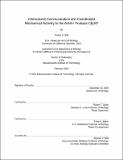Intersubunit communication and coordinated mechanical activity in the AAA+ protease ClpXP
Author(s)
Bell, Tristan A.
Download1154709145-MIT.pdf (8.082Mb)
Other Contributors
Massachusetts Institute of Technology. Department of Biology.
Advisor
Robert T. Sauer and Tania A. Baker.
Terms of use
Metadata
Show full item recordAbstract
Proteases belonging to the AAA+ (ATPases associated with various cellular activities) family perform regulated proteolysis in all domains of life by binding, mechanically unfolding, and degrading target proteins. The bacterial AAA+ protease ClpXP is composed of two distinct proteins: ClpX, a ring-hexamer protein unfoldase; and ClpP, a barrel-shaped tetradecameric peptidase. The assembly of ClpX ring hexamers results in extensive interaction between subunits, and the motor exhibits positive cooperativity in both ATP hydrolysis and mechanical activity against substrates. Despite general understanding of the mechanism of protein unfolding and degradation by ClpXP and other AAA+ proteases, how the six unfoldase subunits coordinate their mechanical activity to produce the force required to quickly and efficiently degrade stably folded substrates is unclear. Here, I present experiments that interrogate intersubunit communication and coordination of mechanical activity by Escherichia coli ClpXP. In Chapter I, I review the current understanding of AAA+ protease structure and function as background to contextualize the findings presented in later chapters. In Chapter II, I present structural and functional characterization of a ClpX structural element, termed the hinge-linker, in facilitating communication between subunits of the ring hexamer. In Chapter III and two related Appendices, I present experiments that systematically identified determinants of grip between ClpX and its substrates. These experiments also identified distinct functions for different unfoldase subunits during application of force to bound substrates. In Chapter IV, I present results from a collaborative project that determined structures of ClpXP bound to a protein substrate and biochemically characterized several previously unvisualized elements of ClpX and ClpP. In chapter V, I report the effects of inhibiting relative rotation of ClpX and ClpP on ATP hydrolysis and mechanical activity of the ClpX unfoldase. Using the constraints on mechanism inferred from these findings, I also propose molecular models for processive mechanical activity. Finally, in Chapter VI, I discuss the results presented in previous chapters in the larger context of communication and coordination between subunits of AAA+ protein unfolding motors.
Description
This electronic version was submitted by the student author. The certified thesis is available in the Institute Archives and Special Collections. Thesis: Ph. D., Massachusetts Institute of Technology, Department of Biology, 2020 Cataloged from student-submitted PDF version of thesis. Includes bibliographical references.
Date issued
2020Department
Massachusetts Institute of Technology. Department of BiologyPublisher
Massachusetts Institute of Technology
Keywords
Biology.